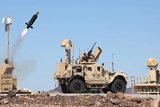Textron Systems, IMSAR integrate NSP-3 into Aerosonde
Textron Systems and IMSAR have successfully demonstrated the capability of the NSP-3 synthetic aperture radar (SAR) integrated on the Aerosonde small UAS, Textron announced on 18 February 2019.
The companies integrated the NSP-3 radar system into the Aerosonde aircraft, with radar electronics in the fuselage payload bay and an externally mounted antenna pod. Software integration included the ability to send radar flight plans directly to the Aerosonde operator.
During multiple flights, the fully integrated system demonstrated day-and-night operations, collecting high-resolution SAR, coherent change detection imagery (CCD) and moving target indication (MTI) detections and tracks. The demonstration included precise cross-cueing of the Aerosonde platform’s full-motion video system from MTI targets that were detected and tracked by the radar system, highlighting the NSP-3 radar system as a sensor and platform multiplier.
The combination of the Aerosonde platform with the all-weather, day-and-night NSP-3 radar system will enable advanced ISR capabilities in a variety of austere locations and extreme weather conditions.
The Aerosonde UAS is equipped for real-time, full-motion video and communications relay within a single flight, day or night.
IMSAR’s NSP-3 multi-mode radar system combines NanoSAR technology with a small size, weight, and power form factor. The NSP-3 can produce high-resolution SAR imagery, CCD, MTI, as well as maritime surveillance in all weather, day or night.
More from Digital Battlespace
-
![Australia looks towards space with force restructure, investment and training]()
Australia looks towards space with force restructure, investment and training
Australia is looking to improve its presence in space with a focus on communications and creating a dedicated segment of its defence forces committed to the domain.
-
![EID to unveil new vehicle communication system at DSEI]()
EID to unveil new vehicle communication system at DSEI
The Portuguese company’s naval communications system is in service across more than a dozen countries. It has turned to its home nation for support in developing a new vehicle based C2 system.
-
![Chess Dynamics successfully demonstrates Vision4ce AI-driven tracker]()
Chess Dynamics successfully demonstrates Vision4ce AI-driven tracker
The Vision4ce Deep Embedded Feature Tracking (DEFT) technology software is designed to process video and images by blending traditional computer vision with artificial intelligence (AI) algorithms to present actionable information from complex environments.
-
![Wave Relay devices cleared for security use on commercial systems in industry trend]()
Wave Relay devices cleared for security use on commercial systems in industry trend
Persistent Systems has been cleared by National Security Agency (NSA) to transmit sensitive data on commercial networks. The devices are added to the NSA’s Commercial Solutions for Classified (CSfC) component list which also includes other companies’ products providing the same security.
-
![UK teases cyber spending boost in Strategic Defence Review ahead of “imminent” release]()
UK teases cyber spending boost in Strategic Defence Review ahead of “imminent” release
The release of the UK’s Strategic Defence Review (SDR) has been long promised as mid-year. It is possible it could be as early as 2 June although the UK Ministry of Defence (MoD) continues to play its cards close to its chest.
-
![Intelsat emphasises SATCOM resilience for SOF in contested domains (video)]()
Intelsat emphasises SATCOM resilience for SOF in contested domains (video)
Intelsat outlines how its multi-orbit SATCOM architecture is enhancing connectivity and resilience for special operations forces operating in degraded and contested environments.

























